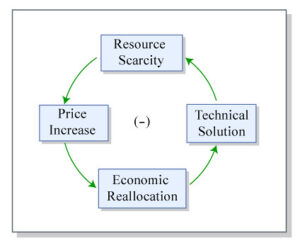
Image source: staticflickr.com
Out of descriptive, predictive and decision analytics, decision analytics are squarely in the here and now. If you look at the Lumina analogy of driving a car, you’ll see several things. Descriptive analytics are the rear-view mirror. That’s where you’ve been. Predictive analytics are your GPS with its possible futures (you can be at different destinations in less than 1 hour, if you take the corresponding routes). Decision analytics are your steering wheel and speedometer, reflecting the real time control of your direction and speed. Yet just as bumps in the road, other drivers and weather conditions may all immediately influence your driving decisions, so it is with decision analytics. What you do gives you feedback. How does this then fit in with decision analytics?
Types of feedback loop
First, let’s look at how feedback loops occur. The basic idea is that the output of a system becomes its input in the next phase or cycle. The decision analytics of a model built with Analytica indicate actions to be taken. These actions modify the data on which the decision analytics are based, and so it continues. The modification or feedback loop can be either balancing or reinforcing.
In a balancing feedback loop, the outputs progressively converge to stabilize at one particular level. A ball bounces less and less and finally stops. By itself, the steering in your car stabilizes rapidly on a straight line (hopefully). In a reinforcing feedback loop, output constantly diverges from its initial level. Squeal from microphones too close to their loudspeakers is one example; debt is another, as compound interest adds to make the amount owed diverge ever more quickly from the initial loan.
Feedback loops in business activity
In the first instance, a company may use decision analytics to continually assess situations and decide what action should be taken. It may want to see either a balancing or a reinforcing business feedback loop, depending on the activity in question. If for instance a company has a ‘cash cow’ that it wishes to maintain in a stable, high-yield state, a balancing loop to converge on required profit levels will be typical. On the other hand, for a new product or service with which the company hopes to dominate the market (a ‘star’), it will be looking for a reinforcing feedback loop: each development, marketing or advertising decision should be pushing the new offering ever higher in terms of profit, market share, popularity or preferably all three.
Agility and responsiveness to feedback
As the decision analytics of a model indicate different courses of action, a company needs to be nimble enough to exploit them. The decision model also needs to be flexible and responsive enough to integrate the new input, including possible new factors that become important along the way. Analytica does this, thanks to a highly visual orientation for clarity, and technology that makes it easy for users to adjust and extend even complex models. Feedback loops can then be managed, encouraged and used to achieve company goals – without driving the business model off the road.
If you’d like to know how Analytica, the modeling software from Lumina, can help improve your visibility and management through decision analytics, then try the free edition of Analytica to see what it can do for you.






